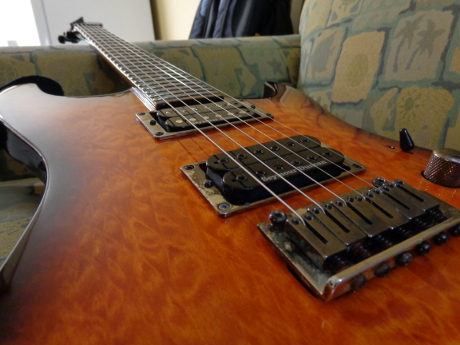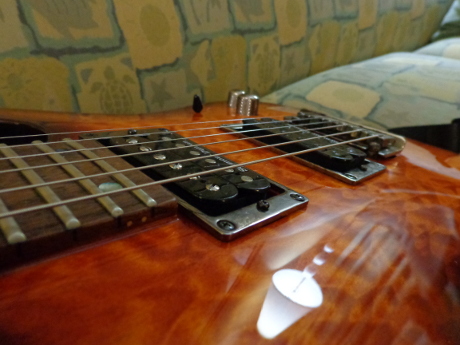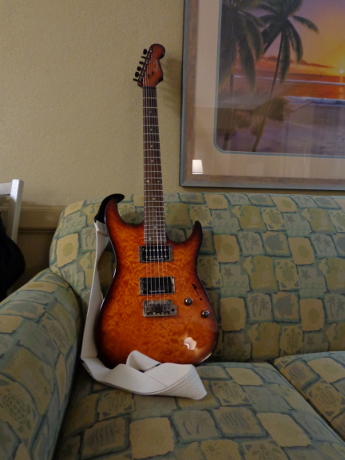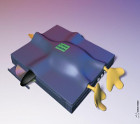My 2004 Fender Showmaster QMT HH
This guitar rocks! I played one in the music store bought
one (see the other page), then sold
it, then regretted it. Lesson learned: If you find your
perfect guitar, buy it and change the pickups. Don't depend
upon keeping it stock to sell it: that's a pipe dream for anything
other than the very desirable guitars. So I bought this one
in 2013. I bought a Seymour Duncan Jazz
neck (reverse wound, reverse polarity, wound by MJ herself at Seymour Duncan) and the Full
Shred Trembucker, both from Seymour Duncan, my favorite
electric guitar pickups company.You see, I read a really old review of the Full Shred on some random music store on the internet from like 2004, some church guitarist who said that the Full Shred was amazing in worship. At the time I didn't believe it, but the memory of that review stuck in my mind. So then I decided to buy one and I've been incredibly happy with it!
Of all the guitars I've ever owned, this one is probably close to the best, aside from my ESP EC-1000QM. And such a pity, too, because it was a great guitar that Fender didn't know how to market properly. If it had come with dual Full Shred pickups, and possibly staggered locking tuners and a Floyd Rose, it would've done much better on the market. So as such, I consider this the most underrated guitar Fender ever produced: a true "sleeper" guitar.
Images



Sound Clips
Here are some half decent sound clips.
All are recorded using a Boss BR-80. I am playing through
a Boss ME-70 and either my 1972 Fender Twin Reverb equipped with
Celestion Classic Lead speakers or my stock Fender Pro
Junior. On the Twin Reverb, my volume and tone knobs on
the guitar are at max, and all EQ on the amp is at 5.
Trust me, this was a spur of the moment thing, so don't hate on
my playing: I'm mostly just goofing off.
The other clips that are live are through my
same rig but using my Fender Pro Junior, volume at 2, tone at
half.
clip 1: Neck pickup
through bluesy setting.
clip 2: Bridge pickup
through bluesy setting.
clip 3: Bridge pickup
through an 80s metal setting.
clip 4: Playing
slide on O Come O Come Emmanuel, live.
clip 5:
Playing in middle position (Jazz + Full Shred) with delay and
reverb on Prepare Him Room, live.
clip 6: This is me
playing a solo on Bless The Lord. I'm using the Full Shred
bridge plus ME-70 (Solo + Blues) into my Fender Pro Junior.
clip 7: The second solo
to the song Always with the Full Shred bridge, through Fender
Pro Junior with "canned" ME-70 patch 5x3 ("crunch with
compressor for solos").
clip 8: The third solo to
the song Always, same values as above.
clip 9:
Playing the solo from "Forever" using the Jazz neck pickup at
full volume.
clip 10:
Playing the solo to "Christ Is Enough" using the Jazz neck
pickup with the Boss ME-70 harmonizer adding the octave below.
Experience Using in a Live Church Environment
So how well does it work out in a live
church environment?
The Jazz
neck sounds fantastic, both clean and in a crunch setting.
This pickup has great sustain and clarity, which is one of the
reasons why it's my favorite neck pickup so far. However,
the Jazz
neck is boomy in the bass range, so keep this in mind for your
amp's settings: you may want to not boost the bass. You
may even want to trim the bass a little. And you may want
(if you're playing into the church sound system) to roll off the
bass. But as for the Full Shred bridge, no bass reduction
is necessary.
The Full
Shred bridge sounds great. The tone is not "earth
shattering", however. It's the cleanest tone you can get
from a high output bridge. It's meant for shredding, so
the tone is a bit towards the "art metal", "prog", and "solo"
tone genre. For a high output passive pickup, it doesn't
immediately come across as loud, like the JB.
The basswood body of this guitar boosts the mids, but the Full
Shred doesn't have a "kick to the face" feeling like the JB.
The JB
in my EC-1000QM does. So when
we do more orchestral stuff in church, the Full Shred sounds
like it fits right in, even with distortion, in a Trans-Siberian
Orchestra kind of way. When I dial up the distortion into
metal territory, it delivers. It stays true to the Marta
Witiw videos on Seymour Duncan's website. So if you
want to do most Japanese art-rock music, this is also the right
bridge pickup for you, at least in my opinion. But in a
way, this pickup is meant for a lot of gain and distortion, due
to how clean it is, so I had to get out of my comfort zone a bit
(i.e. using something stronger than the Blues overdrive setting
on my ME-70).
At first, I had a difficult time getting the
two pickups to cooperate well in my guitar. I confess that
I'm very used to the Jazz/JB
and '59/JB
sets, because of experience with my ESP
EC-100QM and my ESP EC-1000QM
respectively. I'm used to switching to bridge (usually
also with a separate volume control) for solos, because I want
to switch fast, using the pickup selector switch. To my
ears, the Full
Shred didn't seem to have that dramatic increase in output
from the Jazz.
But when I asked our music minister to compare the two, he said
that there's definitely a difference in output, so it was my
ears. I had previously backed the Jazz
away from the strings to the point where it sounded anemic, but
when I put both pickups back to their recommended height and then backed
the Jazz
away only slightly, the guitar started to work better for me.
The 5-way switching on this guitar is what
makes it extremely versatile. In fact, I wish I had this
switching on all of my electric guitars. The split
positions (2 and 4) both do a great job getting close to single
coil "quack." The middle "third humbucker" position gives
a very in-between sound that is quite useful. But it comes
at a cost. First, the neck pickup has to be reverse wound,
reverse polarity (RWRP) this switching to get to work,
necessitating Seymour Duncan Custom Shop pricing (~$160 at the
time of writing). Second, you only get master volume and
master tone, so having a separate volume level for the bridge is
not possible except what you get from pickup height, but then
it's a compromise. You also can't switch faster on songs
requiring "woman tone" like you can when you have separate
volume and tone controls, like on a Les Paul. But you also
get very quick access to exotic switching combinations. A
traditional dual humbucker guitar with a 3 way switch can get
"neck parallel" and "bridge parallel" and "bridge split"
configurations, but it would require push/pull pots, so in a
way, the beauty of the Fender Showmaster 5-way switch is that
it's much easier to wire the guitar up with it.
As for the sustain, this guitar and pickups
have lots of good sustain for church.
In regards to comfort, this guitar is light,
and the neck is comfortable, at least to me. I still do
not like 25.5" scale (preferring 24.75" LP scale), but I can
tolerate it. Having 24 frets is nice even if I don't
utilize them all. This guitar is worth it.
Still on my list of upgrades: a slick string
nut (like graphite and/or Earvana). To be able to use
tremolo in church requires not going out of tune. I rarely
use mine (mostly as extra vibrato), but I keep it floating and
the arm installed.
So all in all, the Showmaster works very well
in church, and additionally, the Full
Shred proved itself to be very good in church. The Jazz
and Full
Shred are definitely an upgrade from the original '59/PG+
it had. If Fender had only put the Full
Shred set in this guitar when it was originally made, it
would've probably done a whole lot better on the market.
But it was an ambiguous guitar. It seemed destined to be a
shred machine, but had the wrong pickups and (by some opinions)
wrong tremolo for that kind of work. The Jackson Dinky is
an example of what the Showmaster could've been: much more
suited to arena rock and shred.
If my Showmaster broke beyond repair, I'd buy
a basswood body Jackson Dinky with the Floyd Rose and then put
the Full
Shred set in it. Showmasters are no longer made, so
finding one that hasn't warped over time is not easy.
Also, the proper 5-way blade switch that splits the pickups is
now difficult to find, so one would need to get a custom switch
from Stewart Macdonald.
Locking Tuners Modification, 9 December 2017
So I discovered that Sperzel
Gotoh-style Staggered Locking Tuners are a direct fit and
install on the Showmaster, except the need to drill new screw
holes on the back. I installed these right before our
church's Christmas music concert and I am very happy with
them! Keep in mind, in this picture, I have not yet
drilled screw holes for the back. They will hold without
them, but I am going to get them drilled so that I have nothing
to worry about.
Note that you can remove the string trees
because these staggered tuners create enough of a
down-angle. It looks weird in the picture, but trust me,
I've measured it twice.
Credits
Earvana, Graphtech, Schaller, Stratocaster, Celestion, Showmaster, Boss, HCT, and Fender are registered trademarks of their respective companies. Seymour Duncan and the stylized "S" logo are all registered trademarks of Seymour Duncan Pickups, with which I am not affiliated.




